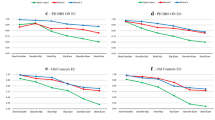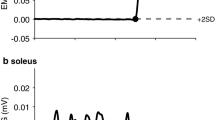Abstract
The effects of subthalamic nucleus (STN) stimulation on the anticipatory postural actions associated with the initiation of gait were studied in ten patients with idiopathic Parkinson’s disease undergoing therapeutic deep brain stimulation. Kinematic, dynamic and electromyographic analysis was performed before and while subjects were starting gait in response to an external cue. Effects of STN stimulation on the standing posture preceding the go signal included significant improvement of the vertical alignment of the trunk and shank, decrease of the hip joint moment, backward shift of the center of pressure (CoP) and reduction of abnormal tonic and/or rhythmic activity in the thigh and leg muscles. Responses to bilateral STN stimulation were more consistent than those evoked by unilateral stimulation. Moreover, comparison between postural changes induced by STN stimulation applied prior to the gait initiation cue and during simple quiet standing revealed more significant responses in the former condition. Effects on the actual gait initiation process included shortening of the imbalance phase, larger backward/lateral displacement of CoP and more physiological expression of the underlying anticipatory muscular synergy. Additional changes were shortening of the unloading phase, shortening of the first-swing phase and increase in the length of the first step. Results demonstrate substantial influence of STN stimulation on functionally basic motor control mechanisms. In particular, the evidence of more significant responses upon attention-demanding conditions and the remarkable effects on postural programmes sub-serving feed-forward regulation of the onset of complex multijoint movements, suggests a consistent action on postural sub-systems relying on cognitive data processing and internal models of body mechanics.







Similar content being viewed by others
References
Allert N, Volkmann J, Dotse S, Hefter H, Sturm V, Freund HJ (2001) Effects of bilateral pallidal or subthalamic stimulation on gait in advanced Parkinson’s Disease. Mov Disord 16:197–201
Armstrong DM (1986) Supraspinal contribution to the initiation and control of locomotion in the cat. Prog Neurobiol 26:273–361
Bastian AJ, Kelly VE, Revilla FJ, Perlmutter JS, Mink JW (2003) Different effects of unilateral versus bilateral subthalamic nucleus stimulation on walking and reaching in Parkinson’s disease. Mov Disord 18:1000–1007
Bazalgette F, Zattara M, Bathien N, Bouisset S, Rondot P (1986) Postural adjustments associated with rapid voluntary arm movements in patients with Parkinson’s Disease. In: Yahr MD, Bergman KJ (eds) Advances in Neurology, vol 45. Raven Press, New York, pp 371–374
Benabid AL, Pollak P, Gervason C, Hoffmann D, Gao DM, Hommel M, Perret JE, de Rougemont J (1991) Long-term suppression of tremor by chronic stimulation of the ventral intermediate thalamic nucleus. Lancet 337:403–406
Benecke R, Rothwell JC, Dick JPR, Day BL, Marsden CD (1987) Disturbance of sequential movements in patients with Parkinson’s Disease. Brain 110:361–379
Bonnot A, Bouc AM, Viala D, Viala G (1996) Effect of posture on the onset of fictive locomotion in the decerebrate rabbit preparation. Neurosci Lett 208:9–12.al
Bouisset S, Zattara M (1981) A sequence of postural movements precedes voluntary movement. Neurosci Lett 22:263–270
Brénière Y, Do MC (1986) When and how does steady state gait movement induced from upright posture begin? J Biomech 19:1035–1040
Brénière Y, Do MC (1987) Modifications posturales associèes au lever du talon dans l’initiation du pas de la marche normale. J Biophys et Biomec 11:161–167
Brénière Y, Do MC, Bouisset S (1987) Are dynamic phenomena prior to stepping essential to walking? J Mot Behav 19:62–76
Brown RG, Limousin Drowsey P, Brown P, Jahanshahi M, Pollak P, Benabid AL, Rodriguez-Oroz MC, Obeso J, Rothwell JC (1999) Impact of deep brain stimulation on upper limb akinesia in Parkinson’s disease. Ann Neurol 45:473–488
Brown P, Mazzone P, Oliviero A, Altibrandi MG, Pilato F, Tonali PA, Di Lazzaro V (2004) Effects of stimulation of subthalamic area on oscillatory pallidal activity in Parkinson’s disease. Exp Neurol 188:480–490
Burleigh-Jacobs A, Horak FB, Nutt JG, Obeso JA (1997) Step initiation in Parkinson’s disease: influence of levodopa and external sensory triggers. Mov Disord 12:206–215
Carlsöö S (1996) The initiation of gait. Acta Anat 65:1–9
Ceballos-Baumann AO, Boecker H, Bartenstain P, von Falkenhayn I, Riescher H, Conrad B, et al (1999) A positron emission tomographic study of subthalamic nucleus stimulation in Parkinson Disease: enhanced movement related activity of motor association cortex and decreased motor cortex resting activity. Arch Neurol 56:997–1003
Crenna P, Frigo C (1991) A motor programme for the initiation of forward-oriented movements in humans. J Physiol (Lond) 437:635–653
Crenna P, Frigo C, Giovannini P, Piccolo I (1990) The initiation of gait in Parkinson’s disease. In: Berardelli A, Benecke R, Manfredi M, Marsden CD (eds) Motor disturbances II. Academic, London, pp 161–173
Dromey C, Kumar R, Lang AE, Lozano AM (2000) An investigation of the effects of subthalamic nucleus stimulation on acoustic measures of voice. Mov Disord 15:1132–1138
Faist M, Kie J, Kurz D, Berger W, Maurer C, Pollak P, Lucking CH (2001) Effects of bilateral subthalamic nucleus stimulation on gait in Parkinson’s Disease. Brain 124:1590–1600
Ferrarin M, Lopiano L, Rizzone M, Lanotte M, Bergamasco B, Recalcati M, Pedotti A (2002) Quantitative analysis of gait in Parkinson’s disease: a pilot study on the effects of bilateral sub-thalamic stimulation. Gait Posture 16:135–148
Ferrarin M, Rizzone M, Lopiano L, Recalcati M, Pedotti A (2004) Effects of subthalamic nucleus stimulation and L-dopa in trunk kinematics of patients with Parkinson’s disease. Gait Posture 19:164–171
Ferrarin M, Rizzone M, Bergamasco B, Lanotte M, Recalcati M, Pedotti A, Lopiano L (2005) Effects of bilateral sub-thalamic stimulation on gait kinematics and kinetics in Parkinson’s disease. Exp Brain Res 160:517–527
Frigo C, Rabuffetti M (1998) Multifactorial estimation of hip and knee joint centres for clinical application of gait analysis. Gait Posture 8:91–102
Gantchev N, Viallet F, Aurenty R, Massion J (1996) Impairment of posturo-kinetic co-ordination during initiation of forward oriented stepping movements in parkinsonian patients. Electroencephalog Clin Neurophysiol 101:110–120
Gelb DJ, Oliver E, Gilman S (1999) Diagnostic criteria for Parkinson Disease. Arch Neurol 56:33–39
Hallet M, Litivan I (1999) Evaluation of surgery in Parkinson’s Disease: a report on the therapeutics and technology assessment subcommittee of the American Academy of Neurology. The task force on surgery in Parkinson’s Disease. Neurology 53:1910–1921
Hanakawa T, Katsumi Y, Fukujama H, Honda M, Hayashi T, Kimura J, et al. (1999) Mechanisms underlying gait disturbance in Parkinson’s Disease: a single photon emission computed tomography study. Brain 122:1271–1282
Horak F, Frank J (1996) Three separate postural systems affected in parkinsonism. In: Stuart DG, Gantchev GN, Gurfinkel VS, Wiesendanger M (eds) Motor control VII. Motor Control Press, Tucson, pp 343–346
Knuttson E, Mårtensson A (1986) Posture and gait in parkinsonian patients. In: Bles W, Brandt T (eds) Disorders of posture and gait. Elsevier, Amsterdam, pp 217–229
Krack P, Batir A, Van Blercom N, Chabardes S, Fraix V, Ardouin C, Koudsie A, Dowsey Limousin P, Benazzouz A, LeBas JF, Benabid AL, Pollak P (2003) Five-year follow-up of bilateral stimulation of the subthalamic nucleus in advanced Parkinson’s disease. New Engl J Med 349:1925–1934
Krystkowiak P, Blatt JL, Bourriez JL, Duhamel A, Perina M, Blond S, Guieu JD, Destee A, Defebvre L (2003) Effects of subthalamic nucleus stimulation and levodopa treatment on gait abnormalities in Parkinson’s Disease. Arch Neurol 60:80–84
Kumar R, Lozano AM, Kim JK, Hutchinson WD, Sime E, Halket E, Lang AE (1998) Double-blind evaluation of subthalamic nucleus deep brain stimulation in advanced Parkinson’s disease. Neurology 51:850–855
Kumar R, Lozano AM, Sime E, Halket E, Lang AE (1999) Comparative effects of unilateral and bilateral subthalamic nucleus deep brain stimulation. Neurology 53:561–566
Lee RG, Tonolli I, Viallet F, Aurenty R, Massion J (1995) Preparatory postural adjustments in Parkinsonian patients with postural instability. Can J Neurol Sci 22:126–135
Limousin P, Pollak P, Benazzouz A, Ardouin C, Hoffmann D, Le Bas JF, Broussolle E, Perret JE, Benabid AL (1995) Effect on parkinsonian signs and symptoms of bilateral subthalamic nucleus stimulation. Lancet 345:91–95
Limousin P, Greene J, Pollak P, Rothwell J, Benabid AL, Frackowiak R (1997) Changes in the cerebral activity pattern due to subthalamic nucleus or internal pallidum in Parkinson’s disease. Ann Neurol 42:283–291
Lopiano L, Rizzone M, Bergamasco B, Tavella A, Torre E, Perozzo P, Valentini MC, Lanotte M (2001) Deep brain stimulation of the subthalamic nucleus: clinical effectiveness and safety. Neurology 56:552–554
Malouin F, Richards CL, Jackson PL, Dumas F, Dojon J (2003) Brain activations during motor imagery of locomotor-related tasks: a PET study, Hum Brain Mapp 19:47–62
Massion J (1992) Movement, posture and equilibrium: interaction and coordination. Prog Neurobiol 38:35–56
Massion J, Viallet F, Massarino R, Khalil R (1989) The supplementary motor area is implicated in the coordination between posture and movement in man. C R Acad Sci Paris, Ser III 308:417–423
Maurer C, Mergner T, Xie J, Faist M, Pollak P, Lucking CH (2003) Effect of chronic bilateral subthalamic nucleus (STN) stimulation on postural control in Parkinson’s Disease. Brain 126:1146–1163
Mori S, Otha Y (1986) Interaction of posture and locomotion and initiation of locomotion in decerebrate cats and freely moving intact cats. In: Grillner S, Stein P, Stuart D, Forssberg H, Herman R (eds) Neurobiology of vertebrate locomotion. Macmillan, England, pp 55–72
Mori S, Sakamoto Y, Otha Y, Takakusaki K, Matasuyama K (1989) Site-specific postural and locomotor changes evoked in awake, freely-moving intact cats by stimulating the brainstem. Brain Res 505:66–74
Nakano K (2000) Neural circuits and topographic organization of the basal ganglia and related regions. Brain Devel 22:S5–S16
Pahapill AP, Lozano AM (2000) The pedunculopontine nucleus and Parkinson’s Disease. Brain 123:1767–1783
Pesenti A, Priori A, Locatelli M, Egidi M, Rampini P, Tamma F, et al. (2003) Subthalamic somatosensory evoked potentials in Parkinson’s Disease. Mov Disord 18:1341–1345
Rocchi L, Chiari L, Cappello A, Gross A, Horak FB (2004) Comparison between subthalamic nucleus and globus pallidus internus stimulation for postural performance in Parkinson’s Disease. Gait Posture 19:172–183
Shroeder U, Kuehler A, Lange KW, Haslinger B, Tronnier VM, Krause M, Pfister R, Boecker H, Ceballos-Baumann AO (2003) Subthalamic nucleus stimulation affects a frontotemporal network: a PET study. Ann Neurol 54:445–450
Siebner HR, Ceballos-Bauman A, Standhart H, Auer C, Conrad B, Alesh F (1999) Changes in handwriting resulting from bilateral high-frequency stimulation of the subthalamic nucleus in Parkinson’s Disease. Mov Disord 14:964–971
Siegfrid J, Lippiz B (1994) Bilateral chronic electrostimulation of ventroposterolateral pallidum: a new therapeutic approach for alleviating all parkinsonian symptoms. Neurosurgery 35:1126–1130
Takakusaki K, Habaguchi T, Ohtinata-Sugimoto J, Saitoh K, Sakamoto T (2003) Basal ganglia efferents to the brainstem centres controlling postural muscle tone and locomotion: a new concept for understanding motor disorders in basal ganglia dysfunction. Neurosci 119:293–308
Thobois S, Martens P, Guenot M, Hermier M, Moillon H, Bouvard M, Chazot G, Broussolle E, Sindou M (2002) Subthalamic nucleus stimulation in Parkinson’s Disease: clinical evaluation of 18 cases. J Neurol 249:529–534
Vidailhet M, Stocchi F, Rothwell JC, Thompson PD, Day BL, Brooks DJ, Marsden CD (1993) The Bereitschaftspotential preceding simple foot movement and initiation of gait in Parkinson’s disease. Neurology 43:1784–1788
Volkmann J (2004) Deep brain stimulation for the treatment of Parkinson’s disease. J Clin Neurophysiol 21:6–17
Wenzelburger R, Kopper F, Zhang BR, Witt K, Hamel W, Weinert D, et al. (2003) Subthalamic nucleus stimulation for Parkinson’s Disease preferentially improves akinesia of proximal arm movements compared to finger movements. Mov Disord 18:1163–1169
Yazawa S, Shibasaki H, Ikeda A, Terada K, Nagamine T, Honda M (1997) Cortical mechanism underlying externally cued gait initiation studied by contingent negative variation. Electroenceph Clin Neurophysiol 105:390–399
Acknowledgements
This work was supported in part by the Italian Ministry of Health, through IRCCS research funding.
Author information
Authors and Affiliations
Corresponding author
Rights and permissions
About this article
Cite this article
Crenna, P., Carpinella, I., Rabuffetti, M. et al. Impact of subthalamic nucleus stimulation on the initiation of gait in Parkinson’s disease. Exp Brain Res 172, 519–532 (2006). https://doi.org/10.1007/s00221-006-0360-7
Received:
Accepted:
Published:
Issue Date:
DOI: https://doi.org/10.1007/s00221-006-0360-7




